22 December, 2002
Scott's Hut
Our last night before leaving for the field camp, we decided to kick
back and do something for fun. Around McMurdo, if you are working on
a science project, you are called a beaker. I'm not sure what the
support staffs are called. I'll have to do some research on that.
Anyway, we Stream Team beakers worked all day today in Crary Lab
getting ready to deploy on the helicopter tomorrow. I worked in the
LTER lab washing about 300 sample bottles that we will use in the
field to collect water and algae samples. The water sample bottles
were first soaked in de-ionized water and then rinsed three times in
the DI water. The algae sample bottles were baked in the muffle
furnace at 450 degrees Celsius, and the caps were washed in a 10%
hydrochloric acid solution. (HCl) I learned a lot about safe lab
practices as we worked all day packing our supplies for the field.
We were tired, but decided to walk out to Scott's hut about 8:00 PM.
It is still amazing to walk outside and have the sun be overhead at
night time! The outside of the hut looks like new wood. I really
thought that the Antarctic program must have built a new shed around
the ancient one to protect it, but I was wrong. It has been
preserved just as it was in the early 1900's when his team was camped
on the point overlooking McMurdo Sound. They chose a site to camp
that has a fantastic view of frozen ocean, mountains, volcanoes and
valleys. We unlocked the door and entered a time warp. We walked
through slowly and quietly. I even felt a bit timid as I turned
corners, wondering if one of the explorers might be standing there
surprised to see us in his home.Everything is left just as the men of
Scott's party had it. There is even a half eaten biscuit in a tin,
pants hanging out to dry on a line strung across the room and raw
seal in a pan to be cooked. I was surprised at how large the hut is.
From pictures I had seen, I thought it was rather small. It actually
has several rooms divided by large blankets hanging from the ceiling.
The ceiling is high. It may even have some sleeping lofts up above,
but we wondered if they lost some heat by having it be so high. They
cooked in a fire pit in a hole in the floor, so the height may have
helped dissipate the smoke that would have been generated. It was
with great reverence that we entered this shrine to the men who lost
their lives trying to explore the unknown.
The Scott hut is a museum, and I found it amazing that everyone is
allowed to check out a key and enter it to explore on your own. You
are trusted to not touch or take anything, and the best part is that
people respect that here. Of course there are severe legal penalties
if you should not follow the rules. But sometimes that does not stop
people from doing wrong back home. Antarctica is special in so many
ways!

1. Discovery Point is the location of one of the huts
built by Sir Robert Falcon Scott. His is an amazing and sad story.
The cross on the hill memorializes the last fatal trek he made
returning from the South Pole where he discovered he was the second
person, not the first, to make it to the Pole.

2. A look inside Scott's hut.
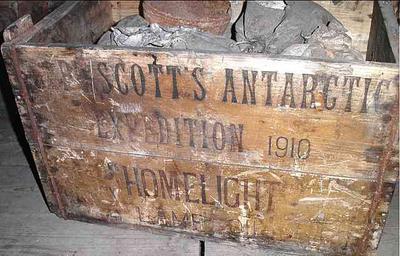
3. A wooden box, marked with Scott's expedition.
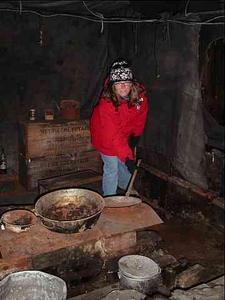
4. Sarah, from the glaciology team, cooking on the
fire.
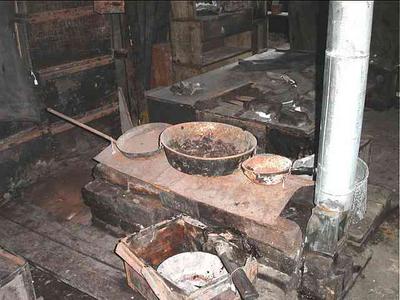
5. Another view of the cooking area.
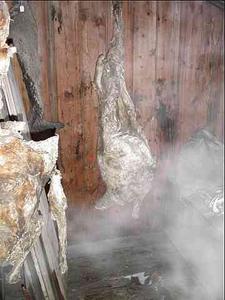
6. A carcass still hangs over the cooking pit. It was so cold
the day we visited, that condensation from our warm clothes and
breath gives the eerie feeling that there is actually smoke coming
out of that ancient fire pit. Could the ghosts of Scott's team still
be there?
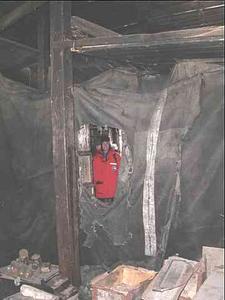
7. Me, looking through the blanket covering the window from
one room of the hut into the other.
Contact the TEA in the field at
.
If you cannot connect through your browser, copy the
TEA's e-mail address in the "To:" line of
your favorite e-mail package.
|
